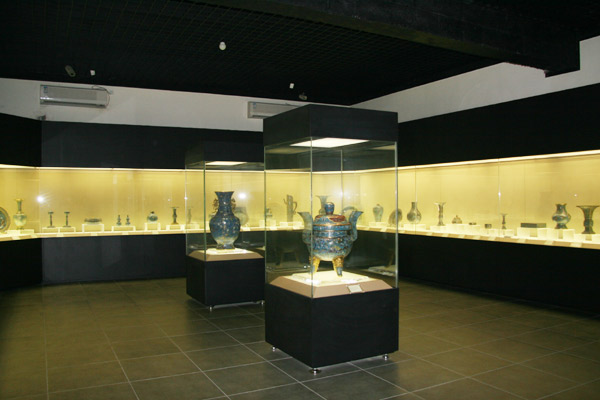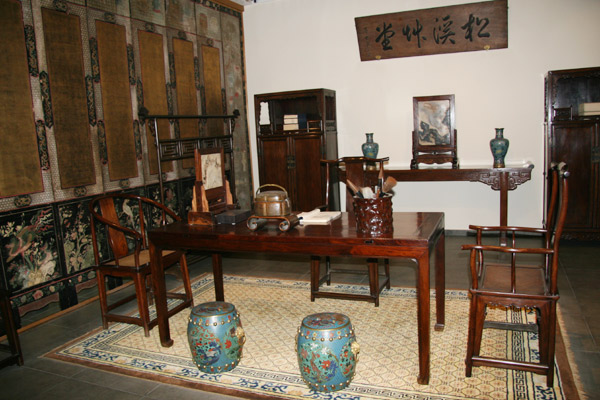 |
|
A typical room resembling Qing dynasty decorated with mahogany furniture. Since Qianlong and Jiaqing period of Qing dynasty, the mahogany furniture has appeared on the stage of noble furniture and become the leading role.
|
Established as the first private, non-profit museum in China, Guanfu Museum has been known as a home of cultural relics collection over the past 12 years. People are fascinated not only by over one thousand extraordinary pieces of art, mainly made in the late Ming and Qing dynasties, but also by its founder Ma Weidu, a well-known antique collector.
I was so excited to have an opportunity to visit this legendary antique world.
Approaching the site of the museum, I was a little bit disappointed by the rows of flat shabby houses in Beijing's eastern suburb of Zhangwanfen, but quickly refreshed by the setting of the building - It's new, draws heavily on Chinese architectural influences and has turned the sleepy district into another tourist attraction.
The museum is one that well combines art appreciation and historical studies. Yao Fang, business supervisor of the museum showed us around the entire building, giving a lecture on the exhibits as well as the fascinating ancient Chinese culture.
The building of Guanfu Museum covers an area of 3000 square meters, and is divided into seven departments, namely ancient porcelain, classic Chinese furniture, works of art, oil paintings, classic doors and windows.
|

|
|
Works of Art department. The permanent exhibition is on cloisonne, enamel wares, golden or bronze figural, bronze, lacquer, jade, classical furniture and hand stone inlaid wares from the Song to Qing dynasty.
|
The transcendent sound of ancient musical instruments and comfortable carefree illustration of Mr. Yao take me back into the ancient times. The exhibition on Chinese porcelain includes about 140 elegant pieces from 10th to 18th century (Tang to Qing dynasty). Each one is a masterpiece that combines artisan intelligence and hard-work, while the porcelain vase with floral panels made in Qianlong era of the Qing dynasty attracts much attention.
The furniture department comprises four parts according to differing structural timber which are mahogany, Zitan wood, Huanghuali wood and Jichi wood, each of which are valuable woods representing high social status.
According to Yao, in the early Qing dynasty, using the valuable wood furniture had come into vogue in the society. In traditionally arranged rooms and studies, I can smell the flavor of classic furniture as well as gain the concept of the arrangement of each room.
The furniture tells of rich Chinese tradition and history. For example, it may seem to be an ordinary setting to place two vases on each end of the table, but Yao tells us the meaning is a blessing for safety, in Chinese, 'Ping Ping An An'. 'Ping' and 'An' together have the same syllables in Chinese as 'safety'.
Each piece of furniture has a unique story behind, making the intelligence and fine technique of ancient artists more admirable.
|

|
|
A room arranged with furnishings modelled on traditional Chinese family style: the study of Huanghuali furniture. The four chairs placed around the table show the status of people sitting on them. The highest ranking person sits on the chair behind the table, and the lowest ranking person sits on the stools in front of the table.
|
In the doors and windows department, I surprisingly found that all rooms are separated, not by walls, but by partition doors and rails which well demonstrate the pattern and rules of traditional room setting during the late Ming and Qing dynasties. I never knew that the design of the wood windows also had deep meanings related to Chinese Fengshui. The most impressive one has to be the partition doors with episodes from the Romance of the Three Kingdoms and antique motif, in which the marvellous technical carving has gained world-wide acknowledgement.
In the oil painting hall, famous contemporary Chinese artists showcase their works, including oil painting and sculpture. Prestigious artist Chen Yifei's painting Violin, Cello, and Chen Danqing's Inamorato are also among the exhibits.
On leaving the museum, I was still deeply immersed in its unique flavor. What a magical place, combining the traditional and the modern, and the pity that I didn't meet its founder Ma Weidu made me yearn to come again.
Guanfu Museum has also opened branches in two other cities. One in Hangzhou, Zhejiang province, was opened in 2001, and another in Xiamen, Fujian province, in 2005.
Admission: 50 Yuan per person
Website: http://www.guanfumuseum.org.cn/
Opening Hours: 9:00- 17:00
Tel: 010-64338887-0 Fax: 010-64362329
How to get there: Take Beijing subway line 2, get off from entry C, then take bus 688 or 909, get down at Zhang Wanfen, and Guanfu Museum is just 100 meteres backwords from the bus stop.